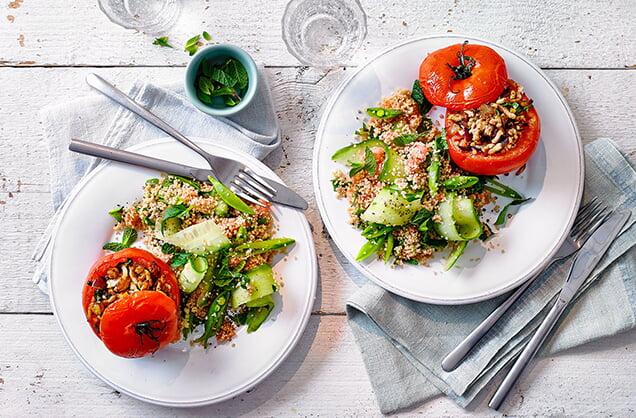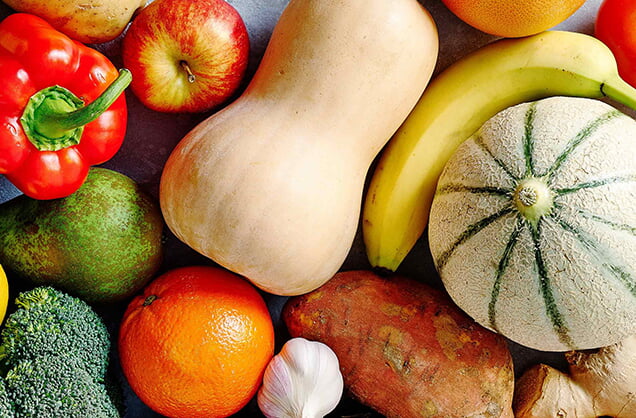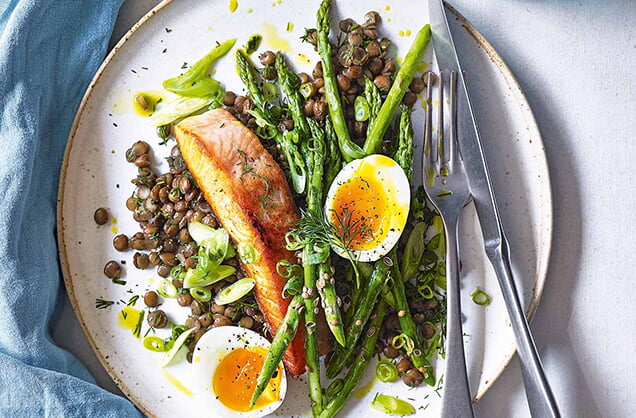Managing type 2 diabetes or prediabetes
If you’ve recently been diagnosed with type 2 diabetes or prediabetes, you may be feeling daunted by lots of new information and wondering how best to manage your condition. The good news is, once you’re following a healthy, balanced diet, you should already be well on your way to managing your overall health. But the food we eat plays an important role in looking after your diabetes and reducing your risk of long term complications. Here are a few ideas to help you:
Go with the grain
Carbohydrates are an important energy source and can make a meal filling, so there’s no need to avoid them when you’re eating a healthy diet. The key is to choose wholegrain wherever possible. This is because wholegrains contain more fibre which is good for our overall health, can help manage cholesterol levels, and they also tend to be digested more slowly, and lead to a slower rise in blood sugar levels than refined versions. Good wholegrain choices include wholegrain bread, wholewheat pasta and brown rice, while refined carbohydrates include white bread, white rice and regular pasta – try to cut down on these in your diet. Never tried wholewheat couscous? It has a chewier texture than regular couscous and a delicious nutty flavour. Try it in these turkey-stuffed tomatoes with wholewheat couscous salad.
Fabulous fibre
Fibre is also found in lots of other foods, from beans and lentils, to nuts and seeds, and fruit and veg. Fresh, frozen, canned or dried fruit and veg all count, and they're an excellent and affordable way to add colour and variety to your diet.

Less sugar, not zero sugar
When it comes to reducing your sugar intake, you will likely know to swap sugary drinks, energy drinks and fruit juices for water, plain milk and unsweetened tea and coffee. But do also remember thirst is often mistaken for hunger, so it’s key to stay hydrated – aim for a daily fluid intake of around 6-8 glasses.
Similarly, swapping sugary snacks like cakes, pastries and biscuits for whole fruit and veg is an easy and refreshing way to satisfy hunger. Keep an eye on sauces and condiments – many, such as ketchup, salad dressings and stir-in sauces often contain hidden sugars. Instead, opt for lemon juice, vinegar, herbs and spices to flavour your food.
Thankfully, having type 2 diabetes or prediabetes doesn’t mean you have to follow a sugar-free diet. Sugary foods can still be enjoyed occasionally, and in small portions – it’s all about balance. Fancy an ice cream? Try this clever, no-churn banana nice cream. Containing bananas and nothing else (great for using up leftovers!), it’s creamy, sweet and indulgent-tasting.

Myth buster
It’s a myth that people with type 2 diabetes can’t eat fruit – whole fruit contains nutrients and fibre and helps you achieve your 5-a-day (that means eating at least 5 portions of fruit and veg daily). Fruit and veg are associated with a lower risk of type 2 diabetes, heart disease and other health conditions, so everyone should eat more fruit and vegetables. There are also certain types of fruit and vegetables, such as berries and green leafy veg, that are linked to a lower risk of type 2 diabetes. Fruits do contain sugar, but it’s natural sugar, and different to the free sugars (also known as added sugar) in things like chocolate, biscuits and cakes or other free sugar found in fruit juices and smoothies.
'Diabetic foods'
'Diabetic' labelling tends to be inaccurately used on sweets, biscuits, jams and similar foods that are generally high in fat, especially saturated fat, sugar and calories. However, foods labelled as “diabetic” or “suitable for diabetics” often contain just as much fat and calories as similar products, and can still affect your blood glucose level. These foods can also sometimes have a laxative effect. There isn’t any evidence that these foods offer you a special benefit over eating healthily and they often cost more than equivalent standard products.
Understanding portions
Portion sizes can affect our weight, and managing your weight is an important part of looking after diabetes. But did you know that portion sizes of some foods, like those containing carbohydrates, can also affect blood sugar levels? Learning to measure portion sizes can feel like a minefield at first but get to grips with the basics and it will soon become second nature. Here are a few ideas:
- Try using smaller plates and bowls to make your portion size look bigger and add plenty of vegetables (without added salt and fat), as they tend to be lower in calories and higher in fibre.
- Weigh certain foods to get an idea of what a portion looks like. This is particularly helpful for starchy foods like rice and pasta. Once you’re familiar with the weight and amount, try using the same container to measure out portions to keep food prep quick and easy.
- Don’t feel you have to eat everything you’ve cooked. You can often cool and refrigerate or freeze leftovers for another time, meaning you don’t eat more than you need and you save money.
Check out Diabetes UK’s guide to portion sizes and diabetes, including a handy list of typical portion sizes for meat, dairy, veg and more.

Fats and salt: What foods to cut down on
We should all be aiming for as healthy diet as possible, but it’s okay to enjoy treats every now and then, and if you’re living with diabetes or prediabetes, the same guidelines apply. However foods high in saturated fat and salt can affect your risk of long term diabetes complications, so let’s delve a bit deeper into fats and salts, and how they can affect your diabetes.
What's the big deal with fats?
Certain saturated fats can increase the amount of bad cholesterol in the blood, increasing your risk of heart problems. And keep in mind that diabetes does increase the risk of developing various cardiovascular diseases. So, look to reduce saturated fats from red and processed meat, ghee, butter, lard, biscuits, cakes and pastries, as these foods tend to increase the amount of cholesterol in the blood.
Smart fat swaps
- Swap red and processed meat, like ham, bacon, sausages, beef and lamb, for healthier protein sources, such as pulses (beans and lentils), eggs, fish, chicken and unsalted nuts. Protein helps keep your muscles healthy and makes a meal more satisfying, so it’s key to swap in healthier protein sources rather than just omit protein from meals.
- Swapping in beans, peas and lentils comes with other benefits: they’re higher in fibre, keep you fuller for longer and don’t affect your blood glucose levels too much. For a light yet satisfying meal, try this high-fibre baked ratatouille with butter bean mash.
- Swap butter, lard and ghee for healthier fats from unsalted nuts, seeds, avocados, oily fish, olive oil, rapeseed and sunflower oil, as these are beneficial for heart health.
- Most of us know that fish is good for us, but oily fish like salmon and mackerel are even better, being rich in omega-3 oil, which helps protect your heart. If you’re living with diabetes, aim to eat two portions of oily fish a week. Try out this simple roasted salmon recipe for two, including lentils which are a good source of fibre, eggs which are a good source of protein, and fresh veg.

- If you’re cooking South Asian food such as dhal or beans, use a small amount of unsaturated fat like sunflower or rapeseed oil instead of ghee. Use a vegetable-based spread on top of rotis instead of butter or ghee and try spreading it on every other roti to cut back on the amount of fat you use.
- Aim to grill, steam or bake food rather than frying to cut down the amount of fat you use in general.
What about salt?
Although salt doesn’t affect blood glucose levels, it’s worth watching your intake, as too much can raise your blood pressure, increasing the risk of heart disease and other conditions.
The majority of salt we eat comes from foods prepared outside the home. Aim to cut down on processed foods where possible, as they tend to be high in salt. This includes ready meals, takeaways, processed meats, cheese, snacks (such as crisps), sauces and condiments, and even some breakfast cereals and bread. Reading the food labels can help you understand how much salt is in a product. Try to choose those with green traffic lights as much as possible.
A small but smart step to reduce your salt intake is to measure how much salt you’re using while cooking (rather than free pouring). Try slowly reducing how much salt you use, then, as your tastebuds adapt, you may be able to cut it out completely. Instead of adding salt, experiment with herbs and spices to keep your dishes interesting. Try this wholesome spiced lentil and spinach salad that’s flavoured with cumin seeds, chillies and parsley.

Get to grips with food labels
Understanding food labels (ingredients and nutrients on packaging) is a key step to managing your diabetes, helping you spot hidden ingredients like sugar, saturated fat and salt. In the UK, the traffic light system makes things a bit easier, helping you make smart choices at a glance. As a general guide, choose foods with more greens and ambers, and fewer reds; to learn more Diabetes UK has further info on understanding food labels.
How to manage food cravings
We all have times when we’re craving a certain food, whether it’s a sweet treat, a savoury snack or a takeaway. It’s fine to eat a little of what you fancy, even if you’re following a healthy eating plan to manage your diabetes. So, here are a few tips to manage those cravings and still enjoy your food.
Understanding your food craving
Are you bored, tired or angry? These feelings can make us feel like we need a certain food, but ask yourself the question: am I hungry? Often the answer is no, and you can find an alternative way to manage your feelings, such as going for a walk or calling a friend. If the food craving won’t go away, could you consider making a healthier twist on what you’re craving? For example, this easy chicken tikka masala, made with Greek-style yogurt instead of cream, is indulgent-tasting and healthier than traditional masala recipes.
Snack attack
If you enjoy snacks, try keeping healthier ones to hand for when food cravings strike. Keep some nuts, breadsticks or oatcakes in your bag for when you’re out and about. At home, enjoy a handful of berries with some plain yogurt, or prep some fresh veggies and a speedy red pepper and feta dip to store in the fridge for a colourful grab-and-go snack. If you’re looking for a more substantial bite, try our one-pan ratatouille eggs, which makes a great veg-packed brunch or lunch too.

Work out a healthy eating meal plan
Having a meal plan can help you avoid last-minute unhealthy choices – it also makes food shopping streamlined and more budget-friendly. With this in mind, we’ve devised a 3-day healthy eating meal plan that’s suitable for people with diabetes and prediabetes. It includes breakfasts, lunches, snacks, dinners and even healthy desserts, so you can plan and prep delicious, fuss-free food.
The plan has been carefully devised to contain at least five portions of fruit and veg each day, helps you meet your calcium requirement with at least two portions of dairy per day (including an allowance for milk in tea/coffee etc), and meets your fibre requirement for an adult. Carbohydrates and protein have been considered and calculated too, for your peace of mind. We've also put together an FAQ guide so you can really make the most of it.
Dining in and out with diabetes
While home-cooking helps you manage what you are eating, you can still enjoy parties and gatherings, plus meals out, while managing your diabetes and prediabetes. Here are a few ideas to help:
Be the host and take control
If you’re the host, you can serve up delicious, healthy meals, such as grilled fish or chicken, and colourful salads, without anyone feeling like they’re missing out on nice food. Try these crispy roast chicken thighs with beetroot and chickpea salad. For a larger gathering, you could set up a build-your-own taco or fajita table with lighter as well as more traditional fillings, letting guests help themselves. Flavoursome and fun!

Plan ahead when eating out
Most restaurants offer menus online, so check for healthier options in advance. Look for grilled, baked or steamed dishes, featuring chicken, fish, veg and pulses. Also, don’t be embarrassed to ask for swaps, such as a green salad instead of chips, or for dressings and sauces to be served on the side.
Tell friends and family beforehand
Be honest with your hosts and they’ll likely be more supportive than you’d expect. If it makes you feel more comfortable, offer to bring a healthy dish. For refreshment, if you enjoy a tipple, there’s no need to miss out, just remember UK recommendations are to limit alcohol to 14 units a week. If you take insulin or other diabetes medications to manage diabetes, be aware that alcohol can make hypos more likely to happen – Diabetes UK has more information. Opt for spirits with sugar-free mixers, a small glass of dry wine or Prosecco. If you’re not drinking alcohol, sparkling water with a twist of lemon or lime makes a lovely, low-sugar alternative to fruit juice or mocktails.
With a little awareness of a healthy, balanced diet, some smart swaps and clever recipes, you can enjoy delicious meals and treats, while looking after yourself and managing your condition.
If you’re at risk of developing type 2 diabetes and want to learn more, Diabetes UK has some useful healthy eating tips, which could help reduce your risk.
Find diabetes support at Tesco Pharmacies
Tesco Pharmacy offers a dedicated diabetes support service, and the team is specially trained to provide support and information about serious health conditions. The trained team can help you find out if you’re at risk of developing type 2 diabetes by using a free Diabetes UK Know Your Risk Assessment. Tesco pharmacists can also offer free blood pressure checks, which can help identify high blood pressure and reduce the risk of heart disease. They can also advise on lifestyle changes and assist with GP referrals.
Diabetes UK are the leading charitable funder of diabetes research in the UK, and it’s their mission to tackle diabetes, day in and day out, until it can do no harm. They campaign for better care, give support in times of need and fund groundbreaking research into new treatments and a cure.
